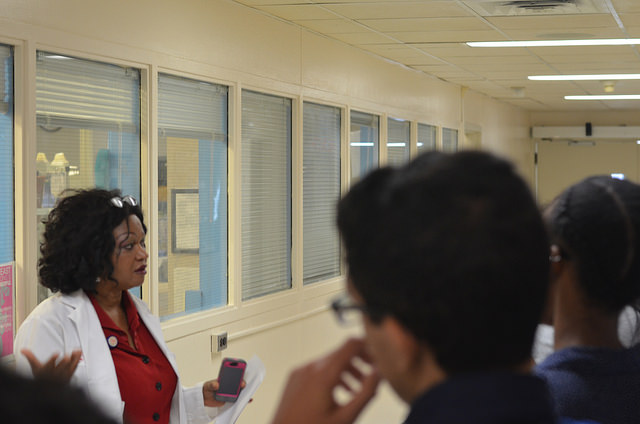Patients rarely get a chance to get an in-depth look at the inner-workings of hospitals in their community. But that’s exactly what 38 high school students experienced at this year’s Physician Diversity Pipeline Project on July 28th.
As the healthcare landscape changes in New Jersey to address the physician shortage, CIR leaders at Rutgers New Jersey Medical School (NJMS) have chosen their own approach to build the physician pipeline as well as expose youth of color to the field of medicine. In partnership with the S.M.A.R.T., a pre-college enrichment program designed to cultivate students’ interest in health science and research program, CIR invited local high school students to Rutgers University Hospital for a day-long program that included a tour, panel discussion and a chance for students to meet residents of color who are passionate about serving their community.
“If we can do it, SO CAN YOU!” was the name of the morning panel and Q&A where students got a chance to find out more about careers in medicine. Drs. Jessica Edwards and Neil King shared their challenges, fears and experiences from medical school through residency and talked about the importance of diversity in the field–from physicians to researchers, nurses and hospital administrators.
“It’s important to demonstrate to students at a young age that it is possible to do this. I think a lot of people approach medicine and they think it’s daunting but we can provide an example to show that you can be a normal person and get into the field,” said Dr. Neil King a surgery resident.
In the afternoon, students were led on a hospital tour with residents and medical students which included stops at the NICU, ER, Trauma, Ambulance and Rescue Track.
“What happens if a person gets the wrong blood type by accident?” one of the students asked in the Trauma ER. Trauma  nurse, Deborah Kanobel didn’t just answer the question–she showed students the mini-blood bank, explained how blood is stored and how universal blood types worked. In the ER, students got a chance to see healthcare providers caring for patients in a fast-paced environment and learned how essential every worker’s role is in keeping patients and staff safe.
nurse, Deborah Kanobel didn’t just answer the question–she showed students the mini-blood bank, explained how blood is stored and how universal blood types worked. In the ER, students got a chance to see healthcare providers caring for patients in a fast-paced environment and learned how essential every worker’s role is in keeping patients and staff safe.
When residents asked students who wanted to go into the healthcare field, almost every hand went up.
“It’s so important for high school students to see people who look like them when they go to their own doctors. It’s important for them to see that this next generation of doctors and know that becoming a doctor is reachable from their age,” said Dr. Jonelle Bailey, a surgery resident.
For these CIR leaders, giving back to the community is an essential part of residency. In three short years, the diversity pipeline project has grown tremendously and both residents and medical students remain invested in cultivating the next generation of healthcare professionals.
“When I signed up to do the S.M.A.R.T program, I thought it would be nice to share my love for science with younger generations, said Chun Tung, a medical student.” I took a slightly different route to get to medical school so I wanted to share that so they know that there are many ways to get to where they want to be. I wanted to try to show them that if you want to do something there’s always a way to get to it and you don’t have to take the same route that other people take.”







